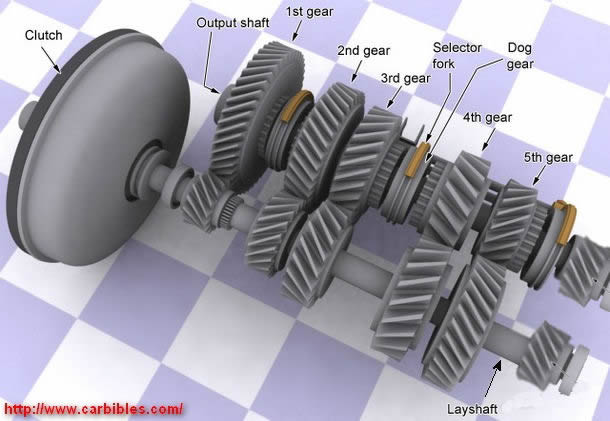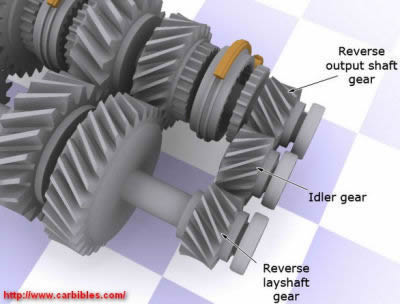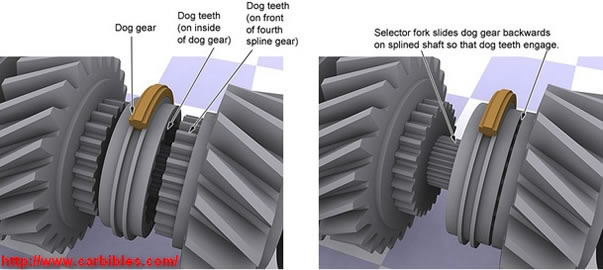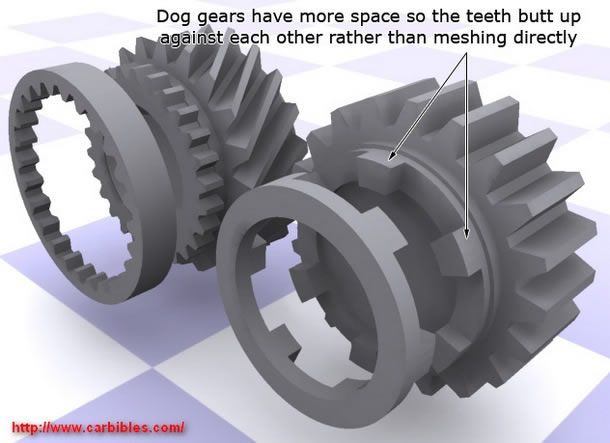Gears
Some great gearbox rendered pictures courtesy of http://www.carbibles.com/
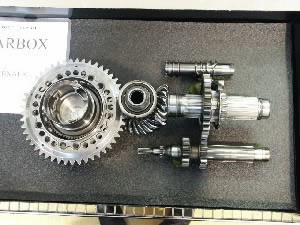 |
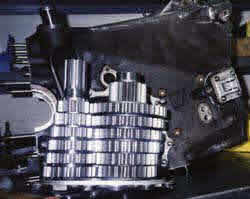 |
Parts of transmition cluster |
|
To know more about "shifter", and to get complete picture, check my article about gearbox and transmission.
From the other articles on this site you know that the pistons drive the main crank in your engine so that it spins. The need for a gear ratios in the gearbox of a car is a consequence of the characteristics of the internal combustion engine. Engines typically operate over a range of 600 to about 7000 revolutions per minute (though this varies, and is typically less for diesel engines), while the car's wheels rotate between 0 rpm and around 1800 rpm. You can't simply connect a set of wheels to the end of the crankshaft because the speed is too high and too variable, and you'd need to stall the engine every time you wanted to stand still. Instead you need to reduce the revolutions of the crank down to a usable value or disengage the engine from the driveshafts. This is known as gearing down - the mechanical process of using interlocking gears to reduce the number of revolutions of something that is spinning.
First we will explain basics of the gearbox and how he work in "normal" cars. Racing cars have more sophisticated gearboxes, and especially Formula one. They are optimized for faster operation and higher forces. More about that later.
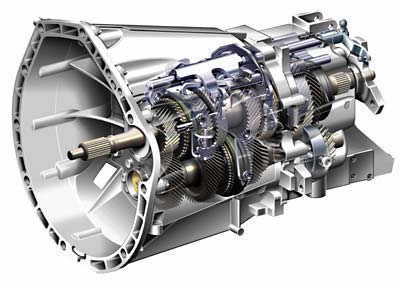 |
A graphic illustration of a Mercedes-Benz C-class sport coupe's six-speed manual gearbox |
A car propulsion consists of a engine and a power transmission system, which provides controlled application of the power to the road. The most common use is in motor vehicles, where the gearbox adapts the output of the internal combustion engine to the drive wheels. Such engines need to operate at a relatively high rotational speed, which is inappropriate for starting, stopping, and slower travel. The gearbox reduces the higher engine speed to the slower wheel speed, increasing torque in the process. Gearboxes are also used on pedal bicycles, fixed machines, and anywhere else rotational speed and torque needs to be adapted. Often, a gearbox will have multiple gear ratios, or simply "gears", with the ability to switch between them as speed varies. This switching may be done manually by driver, or automatically. In car applications, the gearbox will generally be connected to the crankshaft of the engine via clutch. The output of the gearbox is transmitted via driveshaft to one or more differentials, which in turn drive the wheels.
Neglecting mechanical losses you can use gearboxes and differentials to simply reduce speed according to the gearing ratio and to multiply torque by the same factor. As you will see, if you take; P = w x T (P(W, Watts) is the product of rotational speed (w, radians/sec) x by the rotational torque (T, Nm)) and then pass this through a gearbox with a reduction ratio of 2:1 you will end up with; P = (w/2) x (T x 2), whereby you will be moving at half the speed, but able to push more inertia / accelerate quicker.
We can also appreciate that with a fixed amount of power, the lower the revs of the motor, the greater the torque. If you doubt this take a look at a semi-trailer and compare the difference to a fully loaded rig to an empty one. An empty one will even give a standard car a run for its money, but the same car will never be able to haul as much freight!
Most modern gearboxes are used to increase torque while reducing the speed of a prime mover output shaft (e.g. a motor crankshaft). This means that the output shaft of a gearbox will rotate at a slower rate than the input shaft, and this reduction in speed will produce a mechanical advantage, causing an increase in torque.
The gearbox has an input and an output. The mainshaft extends outside the case in both directions: the input shaft towards the engine, and the output shaft towards the rear axle on rear wheel drive cars. Front wheel drives generally have the engine and transmission mounted transversely, the differential being part of the transmission assembly. Both shafts are suspended by the main bearings, and is split towards the input end. At the point of the split, a pilot bearing holds the shafts together.
Types of automobile transmissions include manual, automatic or semi-automatic transmission. There is always some number of gear ratios, in modern cars from 4 to 7, and one reverse gear ratio. The forward gears are all constant-mesh. That means that the gear teeth for all ratios are always engaged with each other at all times. Instead of sliding a gear out of engagement with another gear, the gear is disengaged by disconnecting it from the shaft that it is on. Only one gear ratio pair can be connected to the shaft at one time. The reverse gear is an actual non-constant-mesh sliding gear whose teeth actually slide out of engagement when it's not being used.
Each forward gear can be coupled to its shaft by a sliding locking coupler. This coupler connects splines on the shaft to splines on the gear. The coupler needs to be at the same speed as the gear splines to avoid grinding. When people refer to "grinding the gears", it is actually the splines that are grinding, not the gear teeth. To synchronize the coupler with the gear splines, there is an intermediate device called a synchro-mesh or "dog ring".
One of Webster's definitions for „dog“ is „Any of various devices for holding, gripping or fastening something, as one consisting of a spike or bar of metal with a ring, hook, claw or lug at the end.“
Hold your hands out with fingers spread and your finger tips pointed toward each other. Now move your hands together such that your fingers slip between the fingers of the other hand. Now try to rotate one hand within the other. That is the concept of „Dog ring engagement.“ The fingers or dogs of one hand are engaged with the fingers or dogs of the other hand - they are hooked together.
The synchro-mesh is a lightweight ring with spline teeth on one side, and a conical friction surface on the other side. It is positioned between the sliding coupler and the gear splines. The gear also has a conical friction surface that mates with the surface of the synchro-mesh.
When a gear is to be engaged, the shift linkage selects a sliding coupler to connect to a gear. At this point, the coupler and the gear to be engaged are usually spinning at different speeds. As the coupler starts to slide, it first engages the spline teeth of the synchro-mesh ring. Because the synchro-mesh is lightweight, it can virtually instantly change speed to match the sliding coupler that was just forced into engagement with it. He then becomes part of the coupler. As the coupler continues to slide towards the gear splines, the friction surface of the synchro-mesh ring is pressed into contact with the friction surface of the gear assembly. This friction causes the transmission's input shaft (which at this point is hopefully disconnected from the engine by the clutch) to be accelerated (or decelerated) so that the coupler and the gear are spinning at the same speed when their spline teeth finally engage.
A synchro-mesh is limited in how much mass it can accelerate and how fast it can do it.
I will keep a simplified discussion here!
First thing to understand is that cars’ speeds are limited by gear ratios chosen for different circumstances. Car can't go faster that gear ratio alove him to go. A short gear will result in higher torque but a lower top speed. A long gear will result in lower torque but a higher top speed.
With that in mind, F1 engineers tune F1 gars for each track separately. Again finding the right gear ratio for a F1 car on new track, need a bit of a testing, simulation and experience. On well known track, F1 engineer use data from previous events.
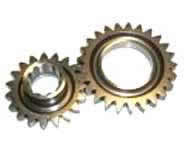
If revs are not reaching the redline at the end of the straight, they can shorten the gears, until they find the revs just reaching the redline. If they find that revs are going up too quickly on a faster part of the track, that normally mean that on slower curvy part of the track they do not have enough power (torque) on the wheels. Adjusting a gear ratio is always a compromise between speed and torque.
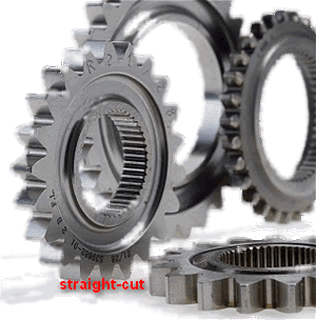 Numbers of teeth on mating gears is caled gear ratio. Ordinarily the ratio is found by dividing the number of teeth on the larger gear by the number of teeth on the smaller gear or pinion. For example, if the ratio is 2 or "2 to 1", this means that the smaller gear or pinion makes two revolutions to one revolution of the larger mating gear.
Numbers of teeth on mating gears is caled gear ratio. Ordinarily the ratio is found by dividing the number of teeth on the larger gear by the number of teeth on the smaller gear or pinion. For example, if the ratio is 2 or "2 to 1", this means that the smaller gear or pinion makes two revolutions to one revolution of the larger mating gear.
All the gears in high performance (racing track use only) cars are straight-cut to minimise power losses and to provide the maximum possible strength and durability; the gears of most roadcar gearboxes are helical, to reduce noise.
 For many years it was the convention on F1 cars to locate the gear clusters behind the differential, for ease of access in order to change gear ratios, although this compromised weight distribution and aerodynamic performance. The current trend, with the gear clusters at the front end of the gearbox, means that the gearbox must be removed to change the gear ratios. The gear cluster (input shaft and output shaft) is mounted in a removable cassette, which can be removed once the gearbox/rear suspension/wing assembly has been removed from the rear of the car.
For many years it was the convention on F1 cars to locate the gear clusters behind the differential, for ease of access in order to change gear ratios, although this compromised weight distribution and aerodynamic performance. The current trend, with the gear clusters at the front end of the gearbox, means that the gearbox must be removed to change the gear ratios. The gear cluster (input shaft and output shaft) is mounted in a removable cassette, which can be removed once the gearbox/rear suspension/wing assembly has been removed from the rear of the car.
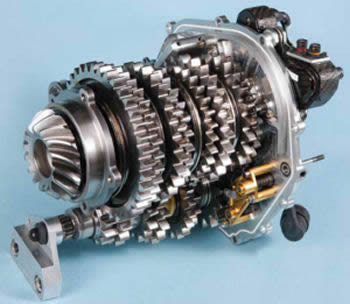 |
The gear clusters in Formula 1 car are mounted in a removable cassette. Much easier to work with gears, but can be removed only when the gearbox/rear suspension/wing assembly are removed from the rear of the car . |
The input shaft and output shaft each carry seven gears (maximum alowed by FIA regulations), and each pair of gears (one on the input shaft and one on the output shaft) is carefully selected to give the required gear ratio. The FIA regulations from 2011 stipulate that each car is allowed 30 pairs of gear ratios from which to choose during the entire season, and these 30 ratios must be declared to the FIA before the first race of the season. The 2010 FIA regulations stipulated that all gears must be manufactured from steel, with a minimum weight (0.6kg) for gear pairs, and a minimum thickness (12mm) for each gear.
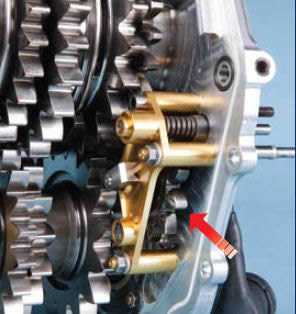 |
When reverse is selected, a solenoid operated intermediate gear (red arrow) is engaged between the input and output shafts. |
All cars must be fitted with a reverse gear to comply with the FIA regulations, and reverse is operated using a button on the steering wheel which engages an intermediate gear between the gearbox input and output shafts to reverse the direction of rotation of the output shaft.
 |
 |
Master gears |
The smallest gear of a gear drivetrain is called pinion. The pinion can be either the driving or the driven gear and is often used in cars as differential pinion or in a rack-and-pinion steering mechanism.
 |
Different versions of dog rings |
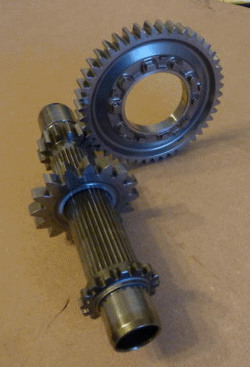 |
Honda F1 2007 Gear Ratio & Layshaft Assembly |
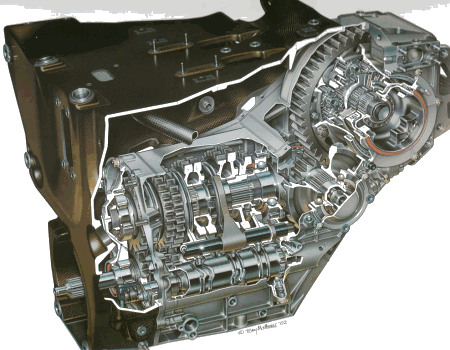
F1 gearbox used by Ferrari during seasson 2000
Check out my Shifting Technique article.

